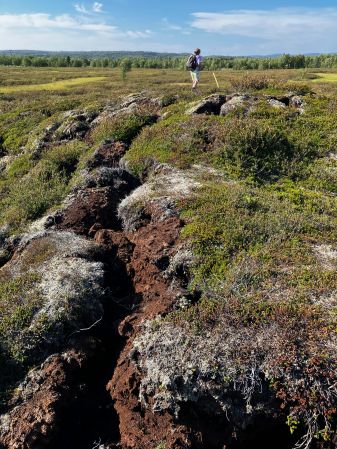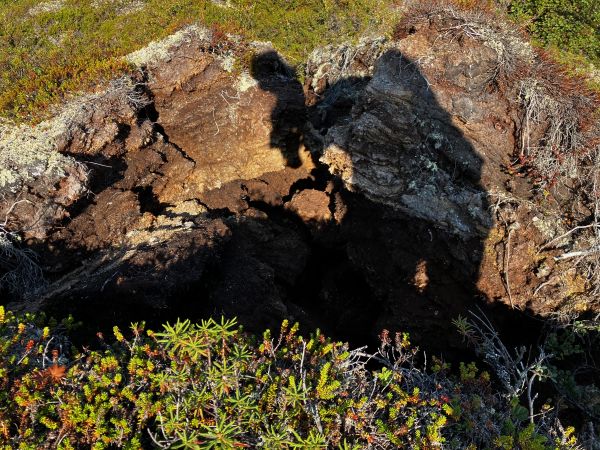The Choreography of the Bucket mire: Difference between revisions
m Hilde moved page Admire palsa mire (choreographic, calligraphic) to The Choreography of the Bucket mire |
m Text replacement - "Category:Fieldwork" to "Category:Responses" |
||
| Line 20: | Line 20: | ||
</gallery> | </gallery> | ||
[[Category: | [[Category:Responses]] | ||
Revision as of 13:30, 22 March 2025
The Choreography of the Bucket mire
A wasp whizzes around the fragrant wild rosemary (Rhododendron tomentosum). It is mid-August and few of the plants are flowering – here and there a late cloudberry plant is in bloom, although most of the berries are already overripe or gone. The mood, nonetheless, is one of exuberant life, an intense vitality.
We are moving from the edge of the road near the Finnish border towards some tantalizing bumps in the landscape. These are palsas, peat mounds formed by sporadic permafrost. They are a way that the earth itself visibly overturns the landscape, several meters of ice underneath laying the soil on top of the surface. An endangered ecosystem, palsa mires have declined in Northern Scandinavia for decades and are likely to disappear from these areas in a few years’ time. They give this small, random bog which most people drive by a certain status, a special value.
Who belongs here?
This mire is rarely frequented by humans. Most mires are heavily visited in the cloudberry season, and one might imagine that the name of this place, Bøttemyra ('Bucket mire'), is a reference to buckets of berries, but it might be too small, and is outcompeted by the much larger, nearby Ferdesmyra (Travellers’ Mire). A reindeer herder has a fence nearby and passes through with his flock. An old working glove and a few pieces of plastic lay partially buried in the bog, excavated signs of past human presence.
The summer air hums. The scents of the mire are overwhelmingly sharp, teasing the nose with fresh and spicy notes. Our bare feet encounter sharp bush twigs and needles when we try to move on the dry top of the mire, teetering between pain and massage. And it is dry indeed. The sun has shone relentlessly, no rain in sight, for many weeks. Bodies seek the softness of the wet moss in the lower parts of the terrain, with the risk of sinking in. Nowhere we walk do we encounter that telltale smell of farts, that would indicate an anaerobic bog. This wetland is fresh.
The two of us walk comfortably, often going our separate ways, then meeting again, weaving our way through a conversation broken by our need to navigate the volumes of undulating and flat substrates. The choreography of the mire moves us, more than we move ourselves. When we finally sit down together, on one of the little peat-arms of the ‘great palsa’, the coolness of its perma-frosty bottom reaches the tailbone. The deep depressions made by the scratches of Finnmarkspors and bircheris on our naked legs give ambiguous messages: We can admire these mires, but we cannot interpret their signals.
Nora S. Vaage & Hilde Meth, Njauddâm/Neiden/Näätämö, by the road between Norway and Finland, 9th of August, 2024

